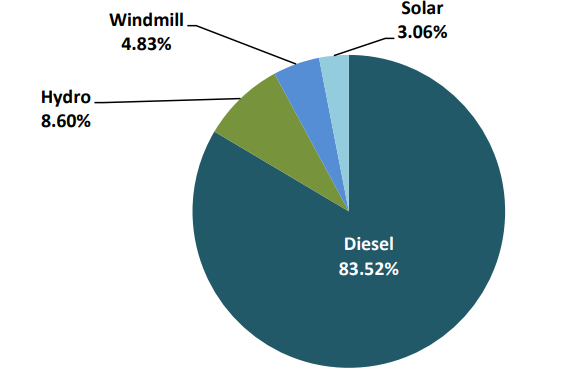
Vanuatu, a small nation located in the South Pacific and part of the Melanesian archipelago, boasts an economy primarily driven by tourism, agriculture, and fisheries. A of 2023, the country had a GDP of USD1.13 billion.[1] Vanuatu has demonstrated a strong commitment to addressing climate change through its Nationally Determined Contributions (NDCs) under the Paris Agreement. The country aims to achieve 100 per cent renewable energy penetration in its electricity generation mix[2]. This ambitious target is also outlined in the National Energy Road Map (NERM) 2016-2030, which serves as the policy framework for the development of Vanuatu's energy sector.
Figure here shows the market share of different energy sources used by regulated utilities in Vanuatu. Diesel is the main source, making up 83.52 per cent of total electricity production. Hydro power account for 8.60 per cent. Windmill power contributes 4.83 per cent, and solar energy makes up 3.06 per cent.[3]
Additionally, the country is exploring the potential of green hydrogen as a means to diversify its energy mix, stimulate economic growth, and attract investment in the renewable energy sector.
[3] 11._Monthly_Energy_Market_Report_November_2024.pdf
As of 2025, Vanuatu is in the early stages of exploring green hydrogen as a component of its long-term energy transition strategy. The government has recognized the role green hydrogen could play in supporting its climate commitments, achieving energy independence, and enabling economic diversification. While there are no large-scale hydrogen production facilities in the country yet, key policy developments and international interest are laying the groundwork for future green hydrogen initiatives.
Vanuatu is a founding member of the Global Green Hydrogen Alliance, launched at COP27, signaling its commitment to developing a green hydrogen sector. The government has also identified green hydrogen in its Updated National Energy Road Map 2016–2030 and climate strategies as a technology of interest for decarbonizing hard-to-abate sectors such as transportation (especially marine transport), energy storage, and possibly even export in the future. [1]
As of April 2025, Vanuatu does not have a dedicated national strategy or roadmap specifically for green hydrogen development.
As of 2025, Vanuatu has not yet established specific hydrogen regulations.
Vanuatu is making significant progress toward a clean and sustainable energy future, guided by its ambitious target to achieve 100 per cent renewable electricity generation by 2030. [1] The country is endowed with a variety of renewable energy resources—including solar, wind, hydropower, and geothermal energy—that are increasingly being integrated into its energy mix to reduce reliance on imported fossil fuels and improve energy access across its many islands.
Vanuatu enjoys high solar irradiance, averaging 5.5–6.5 kWh/m²/day across most islands, making solar photovoltaic (PV) systems highly effective and scalable. [2] The country’s geography allows for decentralized deployment, especially on remote islands. With improved grid infrastructure and energy storage, surplus solar electricity can be redirected for green hydrogen generation—especially in off-grid or mini-grid settings.
As of 2022, solar energy accounts for 2.72 GWh which is 3.5 per cent of renewable electricity generation, with an installed capacity of 0.29 MW [3] . Vanuatu is advancing solar energy with projects like the 3 MWp Efate Solar Farm, which is set to generate 4.2 million kWh annually by mid-2025. This project will boost Efate’s renewable capacity by 38 per cent by 2025 [4] . Another project of 767 kW solar PV installation in Port Vila is underway enhancing energy access and reducing fossil fuel reliance [5] .
Hydropower currently contributes the largest share of renewable electricity in Vanuatu, with the Sarakata hydro plant on Espiritu Santo being the most significant. There is additional small hydro potential on other islands, which could support continuous, baseload power supply for green hydrogen production, particularly in areas with limited diesel access or high generation costs. Hydropower contributes 8.9 GWh, accounting for 11.3 per cent of renewable electricity generation, with an installed capacity of 1.28 MW as of 2022 [6] .
A recent World Bank study revealed that Vanuatu could potentially produce up to 200 MW of wind power. The government is currently assessing the feasibility of setting up wind turbines on various islands to diversify the energy mix and lessen reliance on costly imported fuels. [7]
As of 2022, wind energy represents 3.5 per cent of renewable electricity generation, with an installed capacity of over 3 MW [8] .
Besides solar and wind power, Vanuatu boasts substantial geothermal energy potential due to its volcanic geology, which offers a natural heat source for electricity generation. Initial studies have pinpointed several promising geothermal sites. The government is collaborating with international partners to further evaluate these sites and build the infrastructure needed to harness this resource. [9] Efate is the primary island in Vanuatu with the potential for significant geothermal energy development. Its larger population and existing infrastructure make it a suitable candidate for geothermal projects. [10]
[2] Vanuatu launches country’s first-ever community-run solar power station | United Nations Development Programme
Not applicable .
In October 2024, Stellae Energy, a UK-based green energy solutions company, signed a Memorandum of Understanding (MOU) with the government of Vanuatu to develop sustainable geothermal power projects. The initial phase involves establishing an approximately 8 MW pilot geothermal power plant. In regions lacking adequate grid infrastructure, Stellae Energy plans to produce green hydrogen as a transportable energy carrier. This initiative aims to provide clean energy access to remote communities, commercial and industrial facilities, and the land and marine transportation sectors, thereby enhancing regional sustainability and resilience [1] .